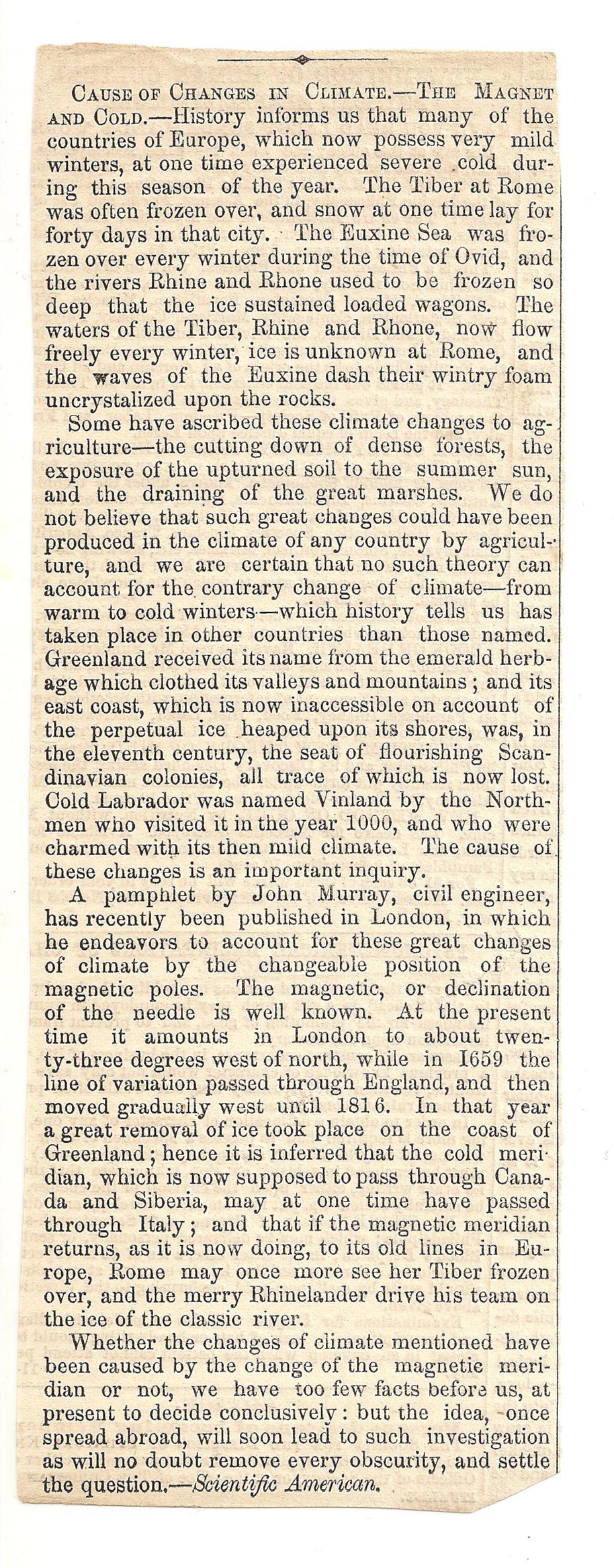1855 Scientific American article discussed the great changes in climate and the strong evidence for a very mild MWP.
CAUSE OF CHANGES IN CLIMATE — THE MAGNET AND COLD.–History informs us that many of the countries of Europe, which new possess very mild winters, at one time experienced severe cold during this season of the year. The Tiber at Rome was often frozen over, and snow at one time lay for forty days in that city. -· The Euxine Sea was frozen over every winter during the time of Ovid, and the rivers Rhine and Rhone used to be frozen so deep that the ice sustained loaded wagons. The waters of the Tiber, Rhine and Rhone, new flow freely every winter, ice is unknown at Rome, and the waves of the Euxine dash their wintry foam uncrystalized upon the rocks.
Some have ascribed these climate changes to agriculture–the cutting down of dense forests, the exposure of the upturned soil to the summer sun, and the draining of the great marshes, We do not believe that such great changes could have been produced in the climate of any country by agriculture, and we certain that no such theory can account for the contrary change of climate-from warm to cold winters –which history tells us has taken place in other countries than those named. Greenland received its name from the emerald herbage which clothed its valleys and mountains , and its east coast, which is now inaccessible on account of the perpetual ice heaped upon its shores, was, in the eleventh century, the seat of flourishing Scandinavian colonies, all trace of which is now lost. Cold Labrador was named Vinland by the Northmen who visited it in the year 1000, and who were charmed with its then mild climate, The cause of these changes is an important inquiry.
A pamphlet by John Murray, civil engineer, has recently been published in London, in which he endeavors to account tor these great changes of climate by the changeable position of the magnetic poles. Tho magnetic, or declination of tho needle is well known. At the present time it amounts in London to about twenty-three degrees west of north, while in 1659 the line of variation passed through England, and then moved gradually west until 1816. In that year a great removal of ice took place on the coast of Greenland; hence it is inferred that the cold meridian, which is now supposed to pass through Canada and Siberia, may at one time have passed through Italy, and that if the magnetic meridian, returns, as it is now doing, to its old lines in Europe, Rome may once more see her Tiber frozen over, and the merry Rhinelander drive his team on the ice of the classic river.
Whether the changes of climate mentioned have been caused by the change of the magnetic meridian or not, we have too few facts before us, at present to decide conclusively: but the idea, -once spread abroad, will soon lead to such investigation as will no doubt remove every obscurity, and settle the question.–Scientific American
h/t to Mike Mellor



19th century climate change deniers.
All caused by horseless carriages. They’ll never happen if congress has it’s way –
Nice find
Excellent post
Some people always want to blame their pet villains for natural events. In the 19th century this story argues against those who blamed agriculture (the “big corporations” of their day) for the Medieval cold times. And the author blames his own pet mythos, magnetic fields, for the same natural and unrelated events. Neither have any more to do with global temperatures than our current fad of blaming CO2. Sometimes “science” is just a crock. All too often. Put lots of salt on it.
How come u didn’t give me credit for that. I found that newspaper clipping in an old book and scanned it.
http://www.hyzercreek.com/1855GlobalWarming.jpg
Actually, Bob, the change in magnetic field might have more to do with it than CO2. Changes in magnetic field might correlate with the sun’s magnetic field. CO2 doesn’t seem to correlate with anything.
OK boys and girls. Who can find the oldest printed use of the term climate change, and how the earth is warming.
This one is from 1807.
Page 71 of “The History of Vermont” by Samuel Williams. He says climate change is caused by clearing trees for agriculture, how the sunlight hits the ground instead of trees:
http://books.google.com/books?id=vWgrAAAAYAAJ&pg=PA71&lpg=PA71&dq=%22in+this+change+of+climate,+the+first+effect+which+is+generally+observed%22&source=bl&ots=oB-qIMrF4u&sig=G6rn8qI4tDbbw1Y8ON1IwPpuulo&hl=en&sa=X&ei=DpJ_UpqDJ5Ci4APvnYGQAw&ved=0CCsQ6AEwAA#v=onepage&q=%22in%20this%20change%20of%20climate%2C%20the%20first%20effect%20which%20is%20generally%20observed%22&f=false
So, it seems that much of the text of our 1855 Scientific American article was taken from an old 1830 edition of the Edinburgh Encyclopedia (a direct competitor of Britannica, also of Edinburgh), written by David Brewster, a giant among scientists who, besides inventing the Brewster Stereoscope, thereby discovering 3D vision, also wrote a whole Encyclopedia. This link shows much of the 1830 Brewster text not included in 1855.
http://books.google.com/books?id=QLVkuSgdGi8C&pg=PA15&lpg=PA15&dq=%22the+climate+of+the+west+of+europe+was+much+colder+in+ancient+than+in+modern+times%22&source=bl&ots=KwdWC39ddb&sig=UG8GTdUmwANcLTHTvFyYTwX03BQ&hl=en&sa=X&ei=BKR_UoHALq__4APsi4HgAg&ved=0CDgQ6AEwBQ#v=onepage&q=%22the%20climate%20of%20the%20west%20of%20europe%20was%20much%20colder%20in%20ancient%20than%20in%20modern%20times%22&f=false
Good grief. On p. 16 he’s talking about the obliquity of earth’s orbit and changes in earth’s axis, 100 years before Milankovic.
Wile E. Coyote has nothing on David Brewster, super genius
Urban Heat Island discovered in 1789:
http://books.google.com/books?id=CIXQAAAAMAAJ&pg=PA270&lpg=PA270&dq=%22On+the+23d+of+May,+1789,+I+sunk+a+thermometer%22&source=bl&ots=X2hw4_xjhc&sig=g0Z0mR2hd9q2PHyKyCTuxtuajaY&hl=en&sa=X&ei=u65_UuaXFMWj4AOOiYDIBg&ved=0CCsQ6AEwAA#v=onepage&q=%22On%20the%2023d%20of%20May%2C%201789%2C%20I%20sunk%20a%20thermometer%22&f=false
Moses Greenleaf in 1829, the first denier of global warming caused by changes in the atmosphere
“It is not, however, in the altered condition of our atmosphere merely, that we are to seek for proofs of (changes in) climate:”
http://books.google.com/books?id=iMn5FdKWjn4C&pg=PA450&lpg=PA450&dq=%22it+is+not,+however,+in+the+altered+condition+of+our+atmosphere+merely,+that+we+are+to+seek+for+proofs%22&source=bl&ots=FLIPYgQcJZ&sig=MJbX-BopGlUBdMHjGU7Z0LWDq8U&hl=en&sa=X&ei=x8V_Uu6eFvGj4AO0roHICg&ved=0CDIQ6AEwAw#v=onepage&q=%22it%20is%20not%2C%20however%2C%20in%20the%20altered%20condition%20of%20our%20atmosphere%20merely%2C%20that%20we%20are%20to%20seek%20for%20proofs%22&f=false
Wait a second. He’s quoting David Brewster. OK, the encyclopedia was published from 1808 to 1830 and I’m not sure whether it was alphabetical. If so, guessing early-mid 1820’s for the volume containing “Polar Regions.”
So there you have it, a global warming denier almost 200 years ago and 100 years before anybody ever thought about an atmospheric greenhouse effect. Back when carbon dioxide was called “fixed air” or sometimes “carbonic acid gas.”
He’s not a global warming denier, just saying it’s not the atmosphere.